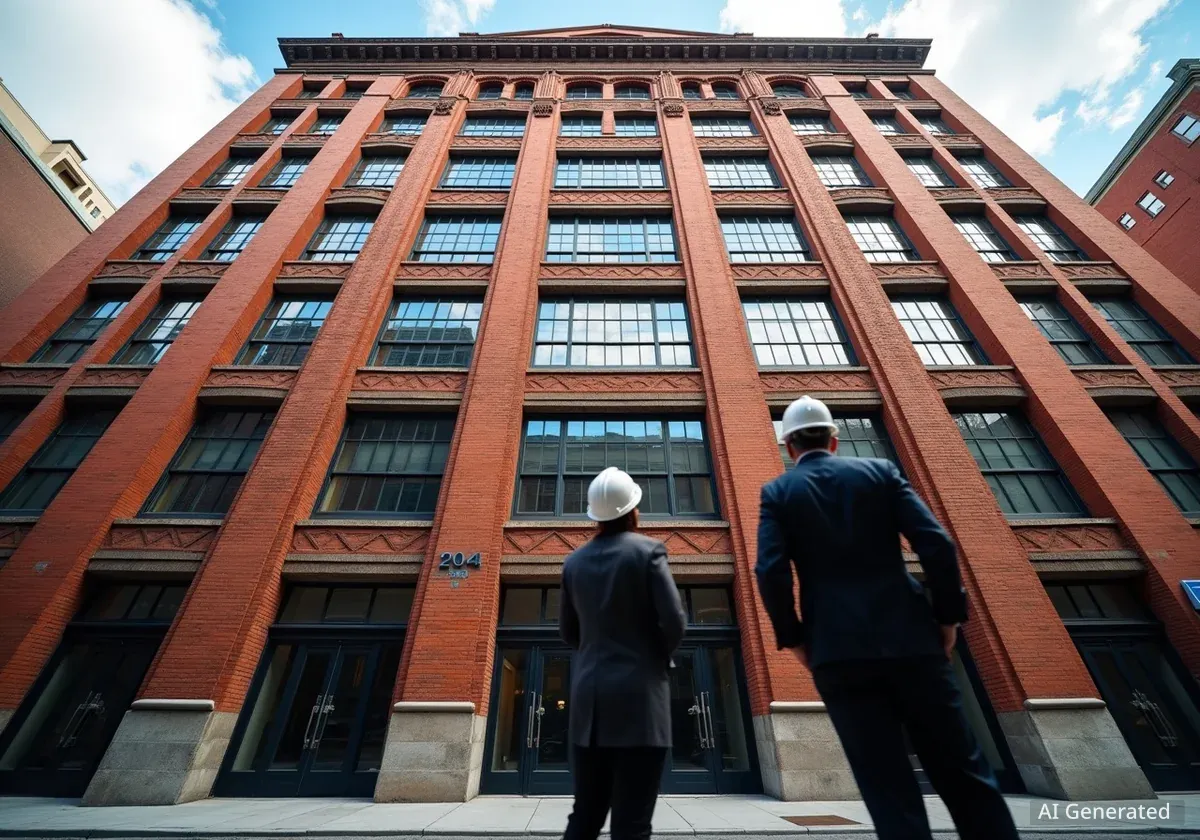Real estate developers KABR Group and Kushner have received the Adaptive Reuse Award from the Jersey City Landmarks Conservancy for their transformation of a historic warehouse. The project involved a $30 million renovation of the 1913 Great Atlantic and Pacific Tea Company (A&P) Warehouse, located at 130 Bay Street.
The century-old structure has been reimagined as the Arts & Powerhouse Building, a modern commercial hub within Jersey City's Powerhouse Arts District. The award also recognized Manhattan-based GRO Architects for their significant role in the building's redesign and preservation.
Key Takeaways
- KABR Group and Kushner won the Adaptive Reuse Award for redeveloping the 1913 A&P warehouse in Jersey City.
- The project cost was approximately $30 million and transformed the building into the Arts & Powerhouse Building.
- Located at 130 Bay Street, the building is a central piece of the Powerhouse Arts District.
- The Jersey City Landmarks Conservancy presented the award, highlighting excellence in historic preservation.
- GRO Architects, the firm responsible for the design, was also recognized for its contribution.
A New Chapter for a Historic Landmark
The building at 130 Bay Street has a long history in Jersey City. Constructed in 1913, it served as a key warehouse and distribution center for the Great Atlantic and Pacific Tea Company, better known as A&P. For decades, it was a vital part of the city's industrial and commercial landscape, supporting one of America's largest grocery chains.
As industrial patterns shifted, the massive structure fell into disuse. Its location in the newly designated Powerhouse Arts District made it a prime candidate for redevelopment. The challenge was to modernize the building for contemporary use while honoring its significant architectural and historical character.
The Powerhouse Arts District
The Powerhouse Arts District is a designated area in downtown Jersey City aimed at creating a community for artists, galleries, and creative businesses. The district's development plan focuses on rehabilitating historic industrial buildings to provide live/work spaces for artists and commercial areas for creative enterprises, preserving the area's unique industrial aesthetic.
The joint venture between KABR Group and Kushner took on this challenge. Their vision was to create a state-of-the-art commercial building that could attract modern businesses while serving as an anchor for the burgeoning arts district.
The $30 Million Transformation
The renovation was a complex, multi-year undertaking with a budget of $30 million. The project focused on what is known as adaptive reuse, a process that repurposes old buildings for functions other than those they were originally designed for. This approach is considered a sustainable alternative to demolition and new construction.
GRO Architects was tasked with the design. A key part of their work involved preserving the building's distinctive exterior, including its brick facade and large industrial windows. These elements were carefully restored to maintain the historic integrity of the structure. Inside, however, the building was completely overhauled.
The interior spaces were converted into modern, flexible commercial lofts suitable for a range of tenants, from technology startups to creative agencies. The renovation included the installation of new building systems, elevators, and amenities expected in a Class A office building, all while exposing original architectural details like high ceilings and structural columns.
Building by the Numbers
- Year Built: 1913
- Renovation Cost: $30 million
- Location: 130 Bay Street, Jersey City, NJ
- Original Use: A&P Grocery Warehouse
- Current Use: Commercial Lofts & Retail
Architectural and Design Highlights
The project successfully blended old and new. According to project descriptions, the design team focused on creating a dialogue between the building's industrial past and its future as a modern workspace. This was achieved through several key strategies:
- Facade Restoration: The original brickwork was cleaned and repointed, preserving the visual character that defines the Powerhouse Arts District.
- Window Replacement: New, energy-efficient windows were installed that replicate the style of the original industrial sashes, allowing for abundant natural light.
- Lobby and Common Areas: A new, contemporary lobby was designed to create a striking entrance, often using materials that complement the building's raw, industrial feel.
- Flexible Floor Plates: The large, open floors of the original warehouse were maintained, offering tenants flexible layouts to design their ideal workspace.
Recognition for Preservation and Vision
The Adaptive Reuse Award from the Jersey City Landmarks Conservancy is a significant acknowledgment of the project's success. The Conservancy is a non-profit organization dedicated to protecting and promoting the architectural heritage of Jersey City. The award signifies that the redevelopment of 130 Bay Street met high standards for historic preservation.
By choosing to renovate rather than demolish, the developers contributed to the environmental and cultural sustainability of the neighborhood. Adaptive reuse projects reduce landfill waste, conserve resources, and maintain a tangible connection to a city's history.
Awards like this one often highlight projects that serve as models for future urban development, demonstrating how historic buildings can be successfully integrated into the modern economy.
The Arts & Powerhouse Building now stands as a testament to this approach. It provides valuable commercial space that supports local economic growth while enhancing the unique character of the Powerhouse Arts District. The project serves as an example of how public-private interest in historic preservation can lead to revitalization that benefits the entire community.
Impact on Jersey City's Development
The transformation of the former A&P warehouse is part of a broader trend of redevelopment in Jersey City. For years, the city has been working to revitalize its post-industrial waterfront and downtown areas. The Powerhouse Arts District is a key component of this strategy, aiming to build a vibrant, creative economy.
The success of the Arts & Powerhouse Building is expected to attract more businesses and investment to the area. By providing high-quality commercial space, it helps Jersey City compete with other urban centers for tenants in the technology, media, and creative sectors.
Furthermore, the project demonstrates the economic viability of preserving historic structures. It shows other property owners and developers that investing in historic buildings can yield both financial returns and community accolades, encouraging similar preservation-minded projects throughout the city.





